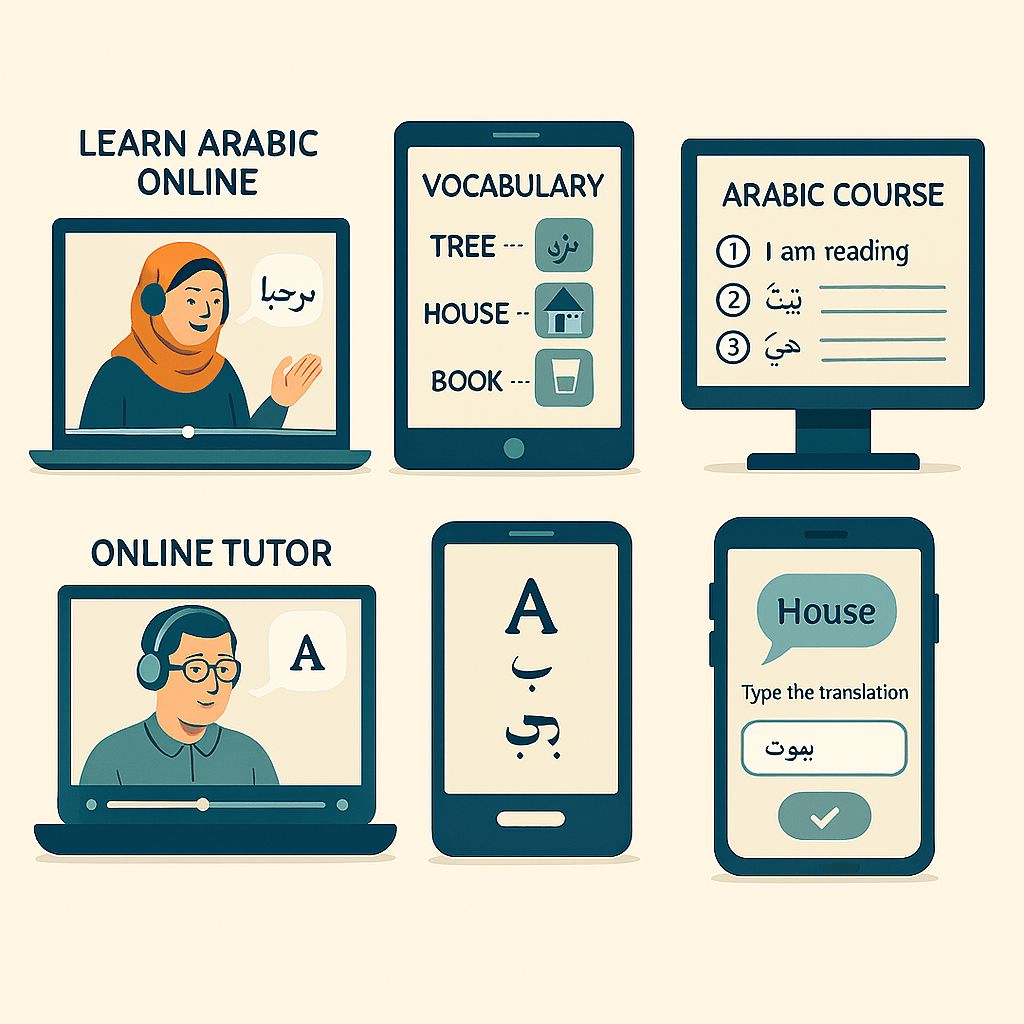Learn Arabic Online: A 5-Step exciting Framework
The internet promises a world of knowledge at your fingertips. You decide you want to learn Arabic online, and a quick search reveals a dizzying universe of options: flashy apps, endless YouTube tutorials, charismatic tutors, and complex courses. It’s the paradox of choice: with so many paths available, you’re paralyzed, afraid of choosing the wrong one and wasting months of effort and money.
This isn’t just a feeling; it’s a reality for most learners. They jump from one method to another, collecting random vocabulary and grammar rules without ever building a solid foundation. But what if there was a smarter way? What if, instead of randomly picking a tool, you had a framework to help you choose the right path for you?
This guide provides that framework. We will walk you through a 5-step process to help you diagnose your needs and select the method that will actually lead to fluency. It’s the same logical framework that we used to build our own “The Fusha Freedom™” methodology , a system designed not just to teach you, but to give you clarity. Let’s begin.

Step 1: Define Your “Why” – The Motivation Matrix
Before you download a single app, you must understand your deepest motivation. Your “why” is the fuel for your journey, and it determines the intensity and type of study you’ll need. Someone learning for a two-week vacation has vastly different needs than someone seeking to understand the Quran. Being honest about your motivation is the most critical first step to successfully learn Arabic online.
We’ve created a “Motivation Matrix” to help you clarify your primary driver. Find your “why” in the table below to understand the level of commitment required and where your focus should be.
| Your “Why” (Motivation) | Required Intensity | Recommended Focus |
|---|---|---|
| Quranic & Spiritual Understanding | Very High | Formal (Fusha), Grammar, Reading |
| Connecting with Heritage | High | Formal & Conversational (MSA) |
| Business & Career Opportunities | Medium to High | Formal (MSA), Business Etiquette |
| Travel & Tourism | Low to Medium | Basic Conversational Phrases |
Understanding your “why” prevents you from trying to learn conversational phrases when your goal is to read ancient texts. This clarity is the foundation of any successful attempt to learn Arabic online.
Step 2: Clarify Your “What” – The Fluency Goals Checklist
After understanding your “why,” you need to define your “what.” “Fluency” is a vague term. What does it actually mean to you? Your end goal dictates the type of material you should study. Someone who wants to debate politics needs a different vocabulary than someone who wants to order food. This is a critical distinction when you learn Arabic online, as different courses are tailored to different outcomes.
Use this checklist to get specific about your goals. Be honest with yourself. Which of these “I want to…” statements truly resonates with you?
The Fluency Goals Checklist:
- [ ] I want to read the Quran with a deep understanding of its meaning and nuances.
- [ ] I want to have meaningful conversations with family members about life and culture.
- [ ] I want to confidently navigate an Arab country, handling everything from taxis to shopping.
- [ ] I want to write professional emails and participate in business meetings.
- [ ] I want to understand Arabic media, like news broadcasts from Al Jazeera or popular films.
- [ ] I want to appreciate the beauty of Arabic poetry and literature in its original form.
Your answers here will act as a filter, helping you eliminate courses and apps that don’t serve your specific “what.”

Step 3: Analyze Your “How” – Discover Your Learning Style
Now that you know your “why” and “what,” it’s time to understand your “how.” We all have a preferred way of absorbing information. Ignoring your natural learning style is a recipe for frustration and failure. If you’re a visual learner stuck in an audio-only course, you’ll struggle, no matter how good the material is. Identifying your style is a key part of finding the best way to learn Arabic online.
There are three primary learning styles. Which one sounds most like you?
- Visual Learners: You learn best by seeing. You remember charts, diagrams, and written text. You’d rather watch a video than listen to a podcast. You benefit from flashcards, infographics, and seeing words written out.
- Auditory Learners: You learn best by hearing. You remember conversations and lectures. You can pick up pronunciation easily just by listening. You benefit from podcasts, audio lessons, and speaking with native speakers.
- Kinesthetic Learners: You learn best by doing. You’re a hands-on learner who needs to be physically engaged. You remember things you’ve written down or acted out. You benefit from interactive exercises, writing practice, and role-playing scenarios.
While most people are a mix, you likely have a dominant style. Keep this in mind as we move to the next step, where we’ll analyze the different methods available to learn Arabic online.
Step 4: Compare The 5 Core Methods to Learn Arabic Online
With a clear understanding of your “why,” “what,” and “how,” you are now equipped to analyze the actual methods available. This is where most people start, but it’s only effective now that you have the right filters. We’ve broken down the crowded market into five core methods you can use to learn Arabic online.
Below is a high-level comparison table. We’ll dive into the details of each method right after.
The 5 Core Methods Comparison
| Method | Best For | Average Cost | Our Rating |
|---|---|---|---|
| 1. Language Apps (e.g., Duolingo) | Casual vocabulary building, Gamification | $ (Freemium) | ★★☆☆☆ |
| 2. Self-Paced Video Courses | Structured, foundational learning | $$ | ★★★★☆ |
| 3. Live Online Tutors (e.g., italki) | Conversation practice, Personal feedback | $$$$ | ★★★☆☆ |
| 4. Free Content (e.g., YouTube) | Immersion, Supplementing other methods | Free | ★★☆☆☆ |
| 5. Hybrid Learning Systems | Serious, comprehensive fluency | $$$ | ★★★★★ |
Now, let’s explore each of these in detail.

Method 1: Language Apps (Duolingo, Memrise, etc.)
These apps are often the first stop for anyone wanting to learn Arabic online. They are masters of “gamification,” using points, streaks, and leaderboards to keep you engaged.
- Pros: Great for building a basic vocabulary foundation. The game-like structure makes it fun and easy to start. They are excellent for kinesthetic learners who enjoy interactive tapping and matching exercises.
- Cons: They are terrible at teaching grammar and sentence structure (the “why” behind the language). You’ll learn words, but you won’t learn how to build your own sentences. Progress often stalls after a few months, leaving you in a “beginner’s trap.”
- Verdict: A useful supplement, but a poor primary method. Use it for 10 minutes a day to drill vocabulary, but do not rely on it to achieve fluency.
Method 2: Self-Paced Video Courses
This category includes structured courses like the ones you’d find on Udemy, Coursera, or specialized language-learning platforms. They provide a clear, step-by-step curriculum.
- Pros: They offer a logical progression, taking you from the alphabet to grammar and beyond. This is ideal for visual learners who benefit from seeing concepts explained on screen. They provide a solid foundation that apps lack.
- Cons: They are a one-way street. There is no one to correct your pronunciation or answer your specific questions. Motivation can be a challenge, as you are entirely on your own.
- Verdict: An excellent choice for building a strong, foundational knowledge of the language, especially for self-motivated learners. This is a powerful way to learn Arabic online if you are disciplined.

Method 3: Live Online Tutors
Platforms like italki or Preply connect you with native speakers for one-on-one lessons. This is the most traditional method, simply moved online.
- Pros: Unbeatable for practicing conversation and getting instant, personalized feedback on your pronunciation. This is essential for auditory learners. A good tutor can tailor lessons to your specific goals and learning style.
- Cons: The cost. This is by far the most expensive way to learn Arabic online. Quality can vary wildly between tutors, and finding a good one takes time and money. It’s also inefficient for learning the absolute basics; you’d be paying a high hourly rate for someone to teach you the alphabet, which you could learn from a course.
- Verdict: A crucial component for intermediate and advanced learners who need to activate their knowledge. It’s less effective and too expensive for absolute beginners.
Method 4: Free Content (YouTube, Podcasts, Blogs )
The internet is flooded with free resources. There are thousands of hours of videos, podcasts, and blog posts dedicated to teaching Arabic.
- Pros: It’s free! You can immerse yourself in the language and find content on very specific topics that interest you. This is great for supplementing your learning and keeping things interesting.
- Cons: It’s a chaotic, unstructured mess. There is no clear path or curriculum. You’ll spend more time searching for what to learn next than actually learning. The quality is inconsistent, and many “teachers” are amateurs.
- Verdict: An essential resource, but a terrible system. Use it to find answers to specific questions or to immerse yourself in the language, but never as your primary learning path.
Method 5: Hybrid Learning Systems
This is a newer, more sophisticated approach. Hybrid systems combine the best elements of the other methods into a single, cohesive ecosystem. This is the model we built with “The Fusha Freedom™”.
- Pros: They provide the structured curriculum of a video course, the community support of a classroom, and often include opportunities for live practice. They are designed as a complete A-to-Z solution, taking the guesswork out of learning. This integrated approach is the most efficient and effective way to learn Arabic online.
- Cons: They require a higher upfront commitment, both in terms of focus and cost, than a simple app. They are designed for serious learners, not casual dabblers.
- Verdict: The gold standard for anyone who is truly committed to achieving fluency. It provides the structure, support, and resources needed to navigate the entire journey from beginner to advanced.
Step 5: Build Your Perfect “Learning Stack”
Now that you understand the core methods, the final step is to stop thinking in terms of “one perfect method” and start thinking like a strategist. The goal is not to choose one, but to build a “Learning Stack”—a combination of tools that work together to serve your specific goals. This is the secret to making rapid progress when you learn Arabic online.
Your stack should be built around a solid foundation and supplemented with other tools.
Building Your Stack: Example Scenarios
- Scenario 1: The “Quranic Scholar”
- Core: A Hybrid Learning System like “The Fusha Freedom™“ to provide the structured curriculum for Fusha.
- Supplement 1: A high-quality Quranic dictionary app for specialized vocabulary.
- Supplement 2: YouTube channels that focus on Tajweed (rules of recitation).
- Scenario 2: The “Heritage Connector”
- Core: A Self-Paced Video Course to build a strong foundation in Modern Standard Arabic (MSA).
- Supplement 1: An Online Tutor (italki) for 1-2 hours a week to practice conversation with someone from your family’s country of origin.
- Supplement 2: A Language App (like Memrise) to drill the specific vocabulary of that country’s dialect.
- Scenario 3: The “Business Professional”
- Core: A Self-Paced Video Course focused on MSA and business Arabic.
- Supplement 1: An Online Tutor specializing in business communication.
- Supplement 2: Following Arabic business news (like Forbes Middle East ) to learn industry-specific terms.

The key is to have a strong, structured Core and use other methods as Supplements, not the other way around. This strategic approach is the most effective way to learn Arabic online.
Conclusion: Stop Searching, Start Learning
The journey to learn Arabic online can feel overwhelming, but it doesn’t have to be. By following this 5-step framework, you’ve moved from being a confused searcher to a strategic learner. You’ve defined your “why,” clarified your “what,” understood your “how,” and analyzed the available methods.
You now have a clear path forward. You understand that the secret isn’t finding one magic app, but building a smart, personalized system. The most effective systems are built on a strong, structured foundation, supplemented by tools that serve your specific goals.
If you are serious about your journey and ready for a comprehensive system that provides the structure, support, and clarity you need, then our Fusha Freedom™” methodology was designed for you. It provides the A-to-Z roadmap that serious learners crave.
Stop the endless searching. Stop jumping from one random video to another. Choose your path with confidence and start your real learning adventure today. The freedom you seek is waiting for you.


